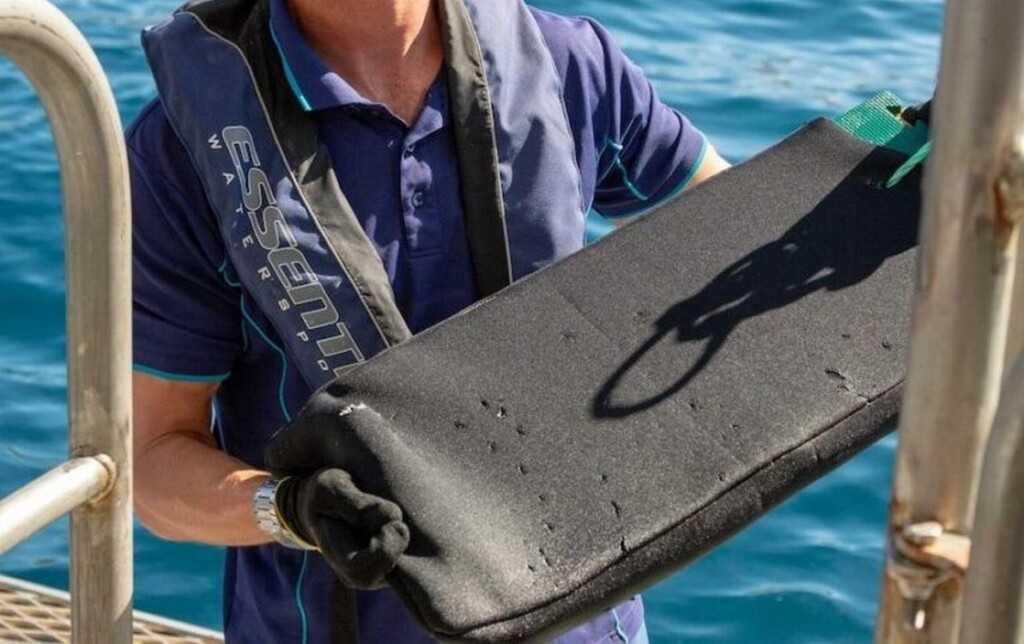Bite-Proof Wetsuit Fabric Almost Entirely Prevents Shark Bite Flesh Wounds

Australian shark experts have tested four bite-resistant materials to assess their ability to reduce injuries and blood loss, and found that
While internal and crushing injuries may still occur, bite-resistant wetsuits can now be added to the ‘toolkit’ of measures available to reduce shark-bite risk and resulting injuries, say researchers from Flinders University’s Southern Shark Ecology Group.
Shark bites on humans are uncommon but can severely impact local coastal communities and businesses, especially where water-based tourism and recreation are common, often prompting pressure for better protection strategies for bathers.
Funded by the New South Wales Department of Primary Industries and Regional Development Shark Management Program, the study tested the efficacy of four bite-resistant wetsuit materials (Aqua Armour, Shark Stop, ActionTX-S, and Brewster material) to reduce lacerations incurred from white and tiger shark bites.
Traditional chainmail suits were protective but too inflexible and heavy for activities like surfing or diving, so the team looked towards new materials that offer a mix of heavy and lightweight fibers and tested them in shark territory.
Visiting Neptune and Norfolk Island, to find white sharks and tiger sharks respectively, they conducted 19 boat trips provoking shark bites and testing the materials. After baiting the water with fish guts, the team would quickly substitute in a wooden board over which a gel that replicates the density of human muscle was applied.
On top of the gel was the wetsuit material, and by jerking it back and forth, managed to convince the sharks to chomp down. Once the animals realized they’d been had and swam away, the researchers would pull the wood up and examine the gel to see how much shredding the sharks’ teeth did.
Dr. Tom Clarke and Professor Charlie Huveneers led a team in assessing each material’s potential in reducing injuries from these sharks by quantifying the amount of bite damage across four categories of increasing severity (ranging from ‘superficial’ to ‘critical’) and comparing it to damage on standard neoprene.

“While there were small differences between the four tested materials, they all reduced the amount of substantial and critical damage, which would typically be associated with severe hemorrhaging and tissue or limb loss,” says Dr. Clarke, from the College of Science and Engineering at Flinders University.
Clarke and Huveneers measured the materials 152 times and found that the tiger shark bites never created a critical wound, and while the white sharks sometimes did, it was still substantially better than normal neoprene, which they also tested.
PREVENTING SHARK ATTACKS:
- Shark Attack App Uses AI to Forecast and Detect Risk for Swimmers at 89% Accuracy
- Queensland Surfers Could Soon be Protected from Shark Attacks With Fleet of Early Warning Drones
- Device Can Repel Sharks By Creating an Electric Field Around Wearer
White and tiger sharks are responsible for the most unprovoked bites and are two of the top three species with the highest rate of fatal bites. Interactions between humans and sharks continue to rise in frequency globally, with expanding coastal populations and rising popularity of marine activities.
“Our study showed that bite-resistant materials incorporated into wetsuits can reduce damage from large white and tiger sharks (up to 3 meters) compared to standard neoprene wetsuit, even from moderate and severe bites,” says Dr. Clarke.
“While these suits don’t eliminate all the risk (e.g. internal injuries may still occur), our results indicate that they can reduce blood loss and trauma from major lacerations and punctures, potentially saving lives,” said Professor Huveneers, who leads the Southern Shark Ecology Group.
“Our findings will allow for informed decisions to be made about the use of bite-resistant wetsuit materials for occupational activities, as well as enabling the public to make appropriate decisions about the suitability of using these products.”
WATCH one of the sharks kindly testing the material…






Please be good and do not spam. Thank you.